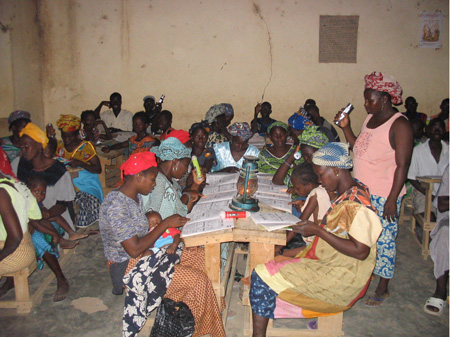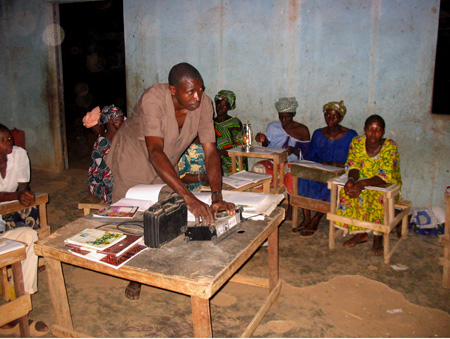Mali
Support for the Quality and Equity of Education
World Education Mali
Country Profile
Population: 13 518 000 (2005)
Adult Litercy Rate: 24 % (2003)
Population below national poverty line: 63.8 % (1999 UNSD)
Context
The World Education Mali Programme, “Support for the Quality and Equity of Education” or “Appui à l’Amélioration de la Qualité et de l’Equalité de l’Education (AQEE)” operates in six regions within Mali: Kidal, Gao, Timbuktu, Ségou, Sikasso and Koulikoro. Within these regions, the programme targets 105 communes in which 2,430,676 inhabitants live, representing approximately one quarter (24.60%1) of the total population within Mali. More specifically, the programme covers 700 schools (300 public schools, 213 community schools, 103 medersa schools, and 4 private schools), 8 teaching academies, and 17 centres for pedagogical training.
Within the framework of the AQEE Program, elimination of illiteracy is integrated with initiatives to increase community participation in the support of schools and children’s education. Key partners in this regard are members of school management committees, members of parents’ associations (mothers’ associations in particular), and other illiterate community leaders who partner with schools.
More importantly, the programme aligns itself with the ten-year strategic plan of the Malian Ministry of Education (called PRODEC), serving as an agent of change and facilitating: a) the improvement of teaching methods and training of children; b) pre-service and in-service teacher training; and c) the increased participation of parents and communities within school management.
The last component of the programme requires literacy training for parents to enable them to follow the school work of their children who receive bilingual instruction in French and a national language.

Programme
In 1999, World Education Mali developed and began piloting literacy programmes that help strengthen community participation in education activities. In April 2002, teachers, community members and NGO staff were brought together to write literacy materials, and in 2003, World Education began incorporating the new literacy materials into the USAID-funded AQEE programme.
The programme serves the Malian community and has the following specific aims:
- To contribute to the improvement of teachers’ performance from the first to the sixth year;
- To support the development and setting of the curriculum to be taught at levels 1 to 4;
- To increase parents’ participation in the management of schools; and
- To increase the population of literate adults within the community leadership.
The specific goal of the AQEE programme is to provide parents and members of community-based organizations with the basic literacy skills they need to enable them to contribute to the management of their local primary schools and the education of their children. Another major objective is to ensure that both parents and children achieve basic literacy. The focus on adult literacy is specifically intended as a complementary means of improving the quality of education for children. Parents who read and write can better monitor and take part in their children’s school work and activities. They can also participate in creating and implementing school improvement plans.
Community members recruit programme participants who meet the following criteria: a) they participate voluntarily; b) they are members of the community in which the literacy programme takes place; c) they are currently illiterate or abandoned formal education at an early age; and/or d) they are members of a school management structure (i.e. school management committee or parent-student association). While other literacy programmes may offer participants a monetary incentive, World Education participants do not receive financial motivation and this is important to the long-term sustainability of the programme. Moreover, World Education has worked to enable elected members to act as community representatives and assume responsibility for selecting trainers and participants and managing the literacy centers.
The programme employs the Sanmogoya2 methodology. Coined by World Education, the methodology is action-based, meaning that participants catalyze change, and utilizes content that is most relevant to the priorities and needs of the participating community. Trainers employ a problem-solving process that aims to help participants solve concrete issues while learning how to read, write and calculate. Facilitators engage learners in dialogue based on visual aids, leading them through a series of questions such as: “What problem(s) is/are these people facing? What are the causes of the problem(s)? Is your community or a neighbouring community involved in the same issue? What can we do to avoid or solve this problem?” Through the Sanmogoya methodology, learners develop a broader understanding of education-related issues in their community and identify relevant solutions to address them within the classroom.
There are two facilitators (one man, one woman) per class of 25 to 30 participants. The community recruits the facilitators based upon the basic criteria that a) they have received basic education; b) they are members of the community; c) they are reliable, available and sociable; and d) they are in agreement with the community’s conditions of motivation. Accordingly, the employment scheme is determined by the specific community in which the facilitator works.
Courses are conducted in one of three Malian languages, Bamanankan, Tamasheq, and Songhaï, determined by the dominant language within the community, and are held four times per week for two hours to reinforce the lessons learned. Basic literacy requires 150 hours in total, which is typically achieved in a six-month period. The programme also integrates lessons covering gender equality and HIV/AIDS into the subject material.
Literacy centres use reading, writing and maths booklets, and image boxes designed for basic education and post-literacy, which are accompanied by a basic education and post-literacy teaching guide for trainers in reading, writing and maths. Trainers supplement these materials with a set of letter games and the “Waligana” or numbers table. For women specifically, there are booklets on post-literacy that include topics of education, health, the environment, good governance and income-generating activities.
World Education also introduced an innovative literacy tool as a result of a public/private partnership called “Kinkajou”, named after a nocturnal animal capable of seeing in the dark. This partnership between USAID, World Education, Design that Matters (affiliated with the Massachusetts Institute of Technology) and the Ministry of Education has allowed a simple and locally-appropriate technology to be tested that enables community members in predominately rural areas to learn to read, write and count under good conditions at night. The system consists of a solar panel that charges a battery daily to power the projector in the evening class. The projector is used in conjunction with the Sanmogoya methodology. An independent evaluation found positive impacts in literacy centres using Kinkajou projectors. In particular, the participants in Kinkajou centres learned material twice as quickly as those in control centres, and displayed lower drop-out rates (66.5% lower among women).

Lessons learned
From the time that is was introduced during the 2003-2004 Malian academic year up to the end of 2006, the World Education literacy programme has successfully served 17,637 basic literacy learners (6,524 women) and 6,831 post-literacy learners (2,260 women). World Education assesses the literacy programme participants through the administering of initial, mid-term and final literacy tests, which follow the evaluation grid established by the Ministry of Education’s bureau of non-formal education as well as the internal and external evaluation of the AQEE program.
Newly acquired literacy skills enabled parents and community members to employ their skills as participants in 756 school management committees and/or parent associations. Community participation within the education system continues to improve as 1,204 community meetings were held to discuss school results and to develop capacity-building plans in 2004-2005 and 2005-2006. The programme is also building a literate environment within the national languages.
World Education noticed an improvement in the quality of school management by literacy programme participants. Participants have also been more active in the supervision of their children’s education at home and at school. In addition, community awareness has increased in areas regarding personal hygiene, reproductive health and HIV/AIDS. Members of participating communities have displayed a strong will to achieve literacy, but have noted that the community cannot reach higher literacy rates without the support of key actors and resources, particularly by way of continued teacher training and material provisions.
Community members have been responsible for managing literacy centres since the beginning of the programme while the regional centres for pedagogic training and teaching academies provide technical support and follow-up on ground-level activities.
Clarifying the roles and the responsibilities for the key actors enables them to participate fully in all aspects of the programme’s implementation and promotes the appropriation of the programme by the local actors (elected community officials, teaching academies, pedagogic training centres, members of the School Management Committee, etc). The communities have been able to assume almost total control of the centres by transferring competencies locally and promoting a community-level mobilization of resources and negotiations with other partners. Community members negotiate the location of the centre, recruit the Karamogos3, select an equal proportion of male and female learners and oversee the operations within the centre. The delegation of authority is an integral part of the World Education Mali strategy and acts as a means of institutionalising the programme.
A systematic challenge is the incorporation of the newly literate into the professional world so that they can become productive members of Malian society and contribute to the country’s socio-economic development. Some former literacy programme participants have gone on to become teachers in training centres for development. The broader challenge is to expand the professional options for this newly literate population.
In addition, the current model delegates the responsibility of proviging motivation to Karamogos to community members. While Karamogos must agree on the conditions of motivation, World Education has found that in some cases, the remuneration is minimal, while in others, Karamogos do not receive any remuneration at all. For World Education, the challenge is to monitor the agreements between the community members and the Karamogos and to ensure that Karamogos receive sufficient motivation.
Contact
World Education Mali
BP 2137
Bamako
Mali
wemali@afribone.net.ml
1Source : United Nations Population Division

 Homepage
Homepage